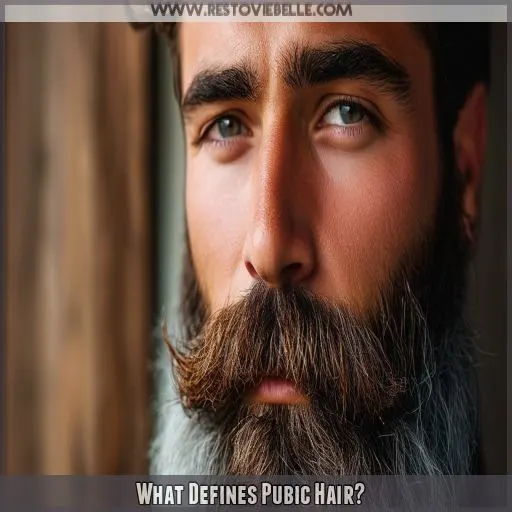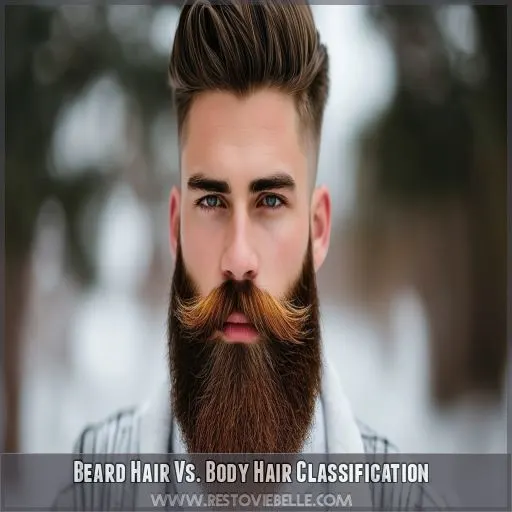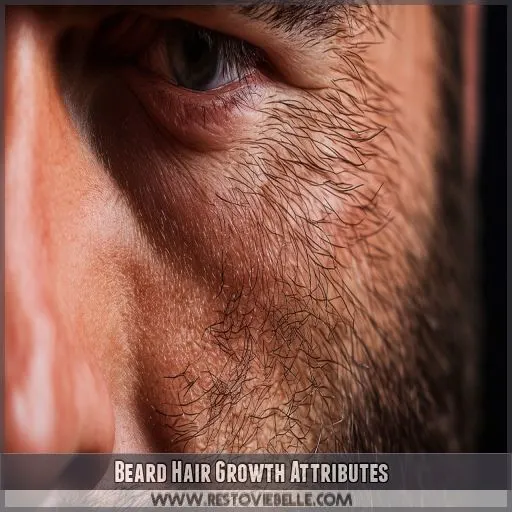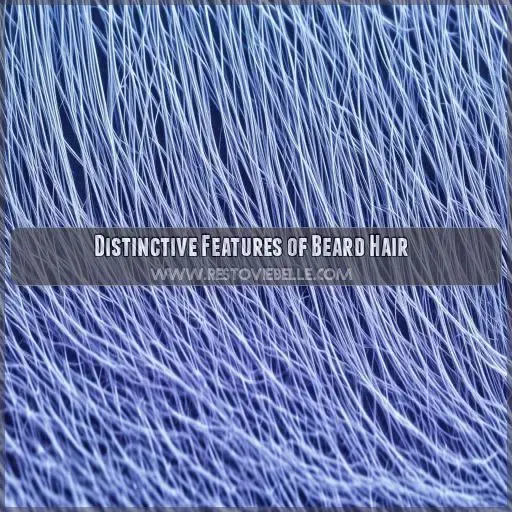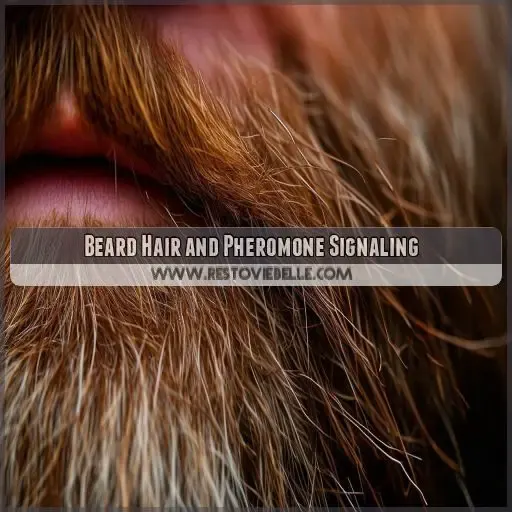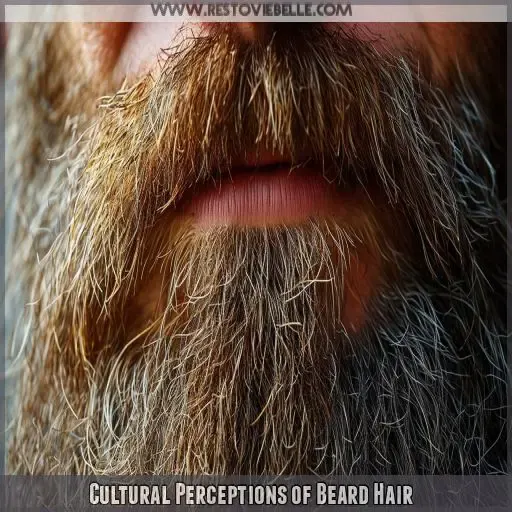This site is supported by our readers. We may earn a commission, at no cost to you, if you purchase through links.
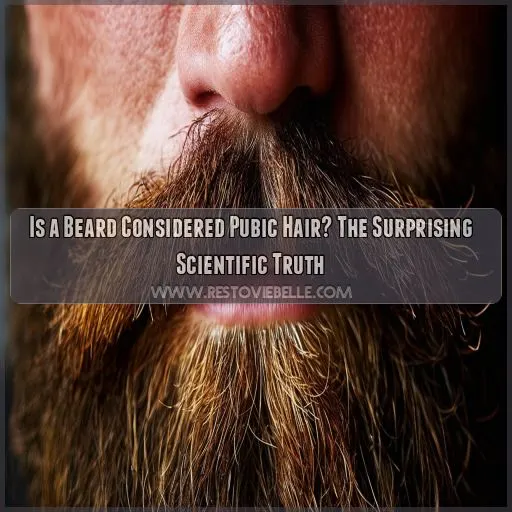
It’s understandable that this comparison raises eyebrows and maybe even concerns.
So, is there any truth to it? Well, let’s just say it’s a little more complicated than a simple yes or no.
Get ready to explore the fascinating science behind beard hair and discover the surprising facts that will forever change how you view facial hair.
Table Of Contents
- Key Takeaways
- Is a Beard Considered Pubic Hair?
- What Defines Pubic Hair?
- Beard Hair Vs. Body Hair Classification
- Beard Hair Growth Attributes
- Distinctive Features of Beard Hair
- Beard Hair and Pheromone Signaling
- Cultural Perceptions of Beard Hair
- Frequently Asked Questions (FAQs)
- What is considered pubic hair?
- Does a beard count as hair?
- Is a beard considered body hair?
- Is armpit hair technically pubic hair?
- Why is pubic hair called that?
- Is there a difference in growth rate?
- Why do beards have a distinct smell?
- What cultural significance do beards hold?
- What are the key differences between beard and pubic hair?
- Conclusion
Key Takeaways
Beards aren’t the same as the hair on your head or your nether regions, but they aren’t totally different either. Your beard has a unique follicle shape and is packed with sebaceous glands, which make your beard hair thicker and give it that distinctive smell. The way your beard grows gives it that signature rugged look. Beards have a long and fascinating cultural history, often associated with symbols of power and signs of rebellion.
Is a Beard Considered Pubic Hair?
While beards and pubic hair are both types of body hair, they fall into different categories. Pubic hair is distinct from other types of hair on the body, whereas beard hair shares similarities with scalp hair in terms of structure and growth. So, no, a beard is not considered pubic hair.
There’s more to uncover about the unique characteristics of beard hair and its differences from pubic hair, so keep reading to find out!
What Defines Pubic Hair?
You might think you know what pubic hair is, but it’s not as straightforward as you’d imagine. Pubic hair terminology has evolved over time, with roots in Latin and Middle English. Remember that awkward "neþir berd" your grandma used to mention? Yep, that’s pubic hair in ye olde speak.
But here’s the kicker: pubic hair isn’t just about location. It’s all about timing – hair that shows up after puberty. This definition throws a curveball at our understanding of hair classification. Suddenly, your beard might be playing for Team Pubes!
Cross-cultural perspectives on pubic hair vary wildly, from taboo to celebrated. The historical context of hair development has shaped social implications and psychological impact. Some cultures view pubic hair as a sign of maturity, while others prefer a smoother look.
Beard Hair Vs. Body Hair Classification
You might be surprised to learn that beard hair and pubic hair share similar follicle compositions, setting them apart from other body hair. The distribution of sebaceous glands also differs, with facial hair having a higher concentration compared to scalp hair, contributing to its unique characteristics.
Hair Follicle Composition
Now, let’s delve into the specific details of beard hair and body hair classification, focusing on hair follicle composition.
The shape and composition of hair follicles play a significant role in determining hair characteristics. When it comes to beard hair and body hair, there are distinct differences in follicle shape and cross-sectional structure. Beard hair follicles have a unique shape that distinguishes them from the follicles of other body hair. This distinct shape contributes to the overall thickness and quality of the hair shaft.
The follicles of beard hair are designed for the growth of terminal hair, which reaches a longer terminal length compared to other body hair. This is in contrast to vellus hair, which is shorter and finer. The shape of beard hair follicles also influences the overall growth pattern and direction of the hair.
Additionally, the follicles of beard hair are associated with a higher concentration of sebaceous glands, which contribute to the distinctive smell and texture of beard hair. These glands play a vital role in lubricating and protecting the hair, as well as releasing pheromones.
Sebaceous Gland Distribution
Now, let’s discuss sebaceous glands. These tiny glands are attached to hair follicles and produce an oily substance called sebum. They’re like the unsung heroes of skin and hair health.
Interestingly, the sebaceous gland activity on your face is more robust than on your scalp. This means that the follicles of your beard hair are surrounded by a higher concentration of sebaceous glands as compared to the hair on your head. It’s like your face is a VIP club, and these glands are the bouncers, keeping things under control and giving your beard a unique scent.
This higher gland activity also contributes to the thickness and texture of beard hair. So, in terms of hair follicle type, your beard hair follicles are in a league of their own, setting them apart from the rest of your body hair.
Beard Hair Growth Attributes
Now, let’s explore the intriguing world of beard hair growth and its unique attributes. Here’s what you need to know about the science behind your beard’s lush growth:
- Beard hair growth is influenced by genetics and hormones: The rate at which your beard grows, its thickness, and its overall structure are determined by a combination of genetic factors and hormone levels, particularly testosterone and dihydrotestosterone (DHT).
- Beard hair has a unique growth pattern: Unlike the hair on your scalp, which tends to grow in a more uniform manner, beard hair often grows in different directions and at varying angles. This unique growth pattern gives your beard its distinct texture and shape.
- Weathering effects play a role: Your beard hair is constantly exposed to the elements, including sun, wind, and pollution. These external factors can impact the health and appearance of your beard, making it more prone to dryness, frizz, and weathering effects over time.
Understanding the science behind beard hair growth is just the beginning. Stay tuned as we unravel more intriguing aspects of beard hair in the next section, where we explore the distinctive features that set your beard apart.
Distinctive Features of Beard Hair
Beard hair stands out due to its thickness, unique texture, and vigorous growth pattern. It serves a distinctive role in pheromone release, setting it apart from other body hair.
Thickness And Texture Differences
Beard hair has some distinct features that set it apart from other types of hair on your body. One of the most noticeable differences is its thickness. Beard hair is generally thicker than body hair, and this is due to evolutionary reasons related to pheromone release, which we’ll explore later.
Another difference lies in the texture of beard hair. The shaft diameter, or thickness, of beard hair can vary, resulting in a range of curl patterns. Some guys have straight beard hair, while others sport a curly mane. This variation in texture gives beards their unique character.
| Feature | Beard Hair | Body Hair |
|---|---|---|
| Thickness | Thicker | Thinner |
| Shaft Diameter | Varies | Uniform |
| Curl Pattern | Curly/Wavy/Straight | Straight |
| Cross-Sectional Shape | Round/Oval | Round |
The cross-sectional shape of beard hair can also differ, appearing more oval or round. These differences in thickness and texture contribute to the signature look and feel of beard hair, setting it apart from the rest of your body hair.
Pheromone Release Function
Aside from the thickness and texture differences, beard hair also stands out due to its role in pheromone release. This function is linked to the higher concentration of sebaceous glands on the face compared to the scalp. These glands produce sebum, which carries pheromones, giving beard hair its distinctive scent.
The release of pheromones from beard hair has been associated with social signaling, particularly in the context of mate selection. It’s an evolutionary advantage, enhancing your sex appeal and attracting potential partners.
Growth Pattern Uniqueness
Beard hair and pubic hair share similarities in their post-puberty growth patterns, with both types of hair appearing and developing after the onset of puberty. This growth pattern uniqueness is one of the distinctive features of beard hair, setting it apart from other forms of body hair.
Beard Hair and Pheromone Signaling
The evolution of beard hair is linked to pheromone signaling and social significance. Beard hair, similar to groin hair, has evolved to be thicker than other body hair, with a higher concentration of sebaceous glands that produce sebum, which carries pheromones. This evolutionary advantage attracted potential mates, enhancing reproductive success.
Today, beards continue to hold social significance, with a dedicated following and cultural associations. Facial hair competitions, fan sites, and trends showcase the aesthetic preferences and cultural stereotypes associated with beards.
Cultural Perceptions of Beard Hair
Beards have a rich cultural history and continue to be a prominent feature in modern society. The perception of beards varies across different cultures and time periods, often reflecting societal norms, gender stereotypes, and aesthetics.
In some cultures, beards are revered and associated with masculinity, wisdom, and power. For example, in many Middle Eastern and South Asian countries, beards are considered a sign of maturity, respect, and religious devotion. On the other hand, in Western cultures, beards have gone through cycles of popularity and disdain, with different eras favoring clean-shaven or heavily bearded looks.
The way people perceive and style their beards is influenced by cultural norms and personal preferences. Some individuals embrace their beards as a form of self-expression, experimenting with different beard care practices and styles. Others may view beards as a burden or a symbol of laziness, opting for a clean-shaven look that aligns with social perceptions of professionalism and hygiene.
The perception of beards also intersects with gender stereotypes. While beards are typically associated with male identity, this perception is evolving. Some women are embracing their facial hair, challenging traditional gender norms, and advocating for body positivity.
Frequently Asked Questions (FAQs)
What is considered pubic hair?
Pubic hair is the coarse hair that grows in the genital area of adolescent and adult humans. It’s found on and around the sex organs, sometimes reaching the inside of the thighs.
Does a beard count as hair?
Yes, a beard is considered hair. It’s facial hair that grows on the jaw, chin, upper lip, cheeks, and neck.
Is a beard considered body hair?
Body hair" is a broad term encompassing various hair types, including beard hair. While beard hair shares similarities with pubic hair, it has distinct characteristics and cultural significance. So, yes, a beard is considered body hair, but it’s more than just that.
Is armpit hair technically pubic hair?
Armpit hair is similar to pubic hair, but it’s not the same. Pubic hair is hair that grows in the pubic region, while armpit hair is classified as axillary hair.
Why is pubic hair called that?
Pubic" comes from the Latin "pubertis," meaning "age of maturity." It refers to hair that grows around the genitals during puberty, marking sexual maturation.
Is there a difference in growth rate?
Yes, there are differences in growth rates between beard hair and pubic hair. Facial hair and body hair require high levels of testosterone, which can cause fluctuations in growth rates.
Why do beards have a distinct smell?
Ever wonder why beards have a distinct smell? Well, it’s mainly due to bacteria buildup, which thrives in the warm, moist environment of a beard. Sebum, a natural oil produced by the skin, can also cause a beard to smell if not cleaned properly.
What cultural significance do beards hold?
Beards have been revered in various cultures as symbols of masculinity, strength, wisdom, and dignity. In ancient Egypt, they signified wealth and power, while in ancient Greece, they were associated with virility and manhood. In the 20th century, beards represented cultural resistance, rugged masculinity, and rebellion.
What are the key differences between beard and pubic hair?
The terminal length of beard hair is longer. Beard hair is exposed to the elements, while pubic hair is protected by clothing. Beard hair can be styled and managed to reduce its resemblance to pubic hair.
Conclusion
Now that you’ve navigated the maze of hair classification and explored the distinctive attributes of beard hair, it’s clear that the question of whether a beard is considered pubic hair is more complex than a simple binary response.
Beard hair and pubic hair share certain similarities, but they also exhibit notable differences in growth patterns, thickness, texture, and even the role of pheromones. These distinct characteristics set them apart within the diverse spectrum of hair types.
Thus, the answer to this inquiry ultimately lies in the perspective of the observer, influenced by cultural contexts and individual interpretations.

